Lori Rader-Day's Blog, page 11
August 18, 2014
Three Questions with…Ben H. Winters
 Ben H. Winters and I met for the first time at the Public Library Association conference in Indianapolis last year, where we and Laura McHugh did a dinner-with-librarians event together. Having dinner with us was a prize. But I’d been aware of Ben’s work earlier, because we both belong to the Midwest Chapter of Mystery Writers of America (he writes from Indianapolis), and Ben won, ahem, an EDGAR AWARD for his book The Last Policeman. It was hard not to be aware of Ben.
Ben H. Winters and I met for the first time at the Public Library Association conference in Indianapolis last year, where we and Laura McHugh did a dinner-with-librarians event together. Having dinner with us was a prize. But I’d been aware of Ben’s work earlier, because we both belong to the Midwest Chapter of Mystery Writers of America (he writes from Indianapolis), and Ben won, ahem, an EDGAR AWARD for his book The Last Policeman. It was hard not to be aware of Ben.
Now the third in his award-winning series, World of Trouble, is out. You’re probably aware of Ben, too, but if not, today’s your lucky day.
Tell us the story of how the idea behind The Last Policeman series came to you?
I was in the fortunate position of having a solid ongoing relationship with a small press, that being Quirk Books, publisher of my unlikely first novel, Sense and Sensiiblity and Sea Monsters. I knew I wanted to do a detective story but I also knew that Quirk was the kind of publisher that wanted some sort of angle, a “big take” on whatever it was I wanted to do. So I think that’s how I arrived at the twist, although I quickly realized that my civilization-destroying asteroid had gifted me with a lot of narratively and thematically interesting places to go.
What do you and Detective Hank Palace have in common?
Well, we’re both tall and thin and ungainly, and we both have been known to use the phrase “holy moly,” despite the contention of some readers that no real human says that. Other than that, we are very different people. He has a keen eye for detail, an ability to connect the dots on complex problems, and a relentless focus on one thing at a time. These are not qualities I share. Oh also he has a loyal dog who has occasionally saved his life—I have a lazy cat who occasionally barfs on my office carpet.
What advice could you give to a writer considering the challenges (and joys?) of writing a series?
Make sure that each book is centered around one case, or one event, with a beginning, middle and end. With its own big questions, big themes, and big conflict that works toward satisfying resolution. A true series is made up of very strong individual novels, not a bunch of pretty good novels that together become something great. I am currently obsessed with Walter Mosley’s Easy Rawlins books, and each alone is magnificent. Especially A Red Death. Go read A Red Death.
You heard the man. Go read! Thanks to Ben for answering three nosy questions and for hosting me on his site a few weeks ago. I got to talk about the Midwest as a sizzling hotbed of murder.
Ben H. Winters is the author of eight novels, most recently World of Trouble, concluding the Edgar-award-winning Last Policeman trilogy. His work for kids includes The Secret Life of Ms. Finkleman and Literally Disturbed: Tales to Keep You Up at Night. You can find out about him at BenHWinters.com or follow him on twitter @BenHWinters or at Facebook.com/BenHWintersIsAWriter
The post Three Questions with…Ben H. Winters appeared first on Lori Rader-Day.
August 6, 2014
Indy Reads event for THE BLACK HOUR
Celebrated the launch of The Black Hour with a couple of events in Indiana (cornfields, represent!). Didn’t get a lot of photos from the event at my childhood hometown library, which is a shame, but I did have a talented friend volunteer to take photos at my event at Indy Reads Books in Indianapolis. Stacy Kagiwada, who takes photos for Nuvo and just because she likes to, gestured to her camera bag before the event and said, “How much documentation do you want?”
Whadyagot?
Thanks to everyone who attended both events. Saw some friends from high school, from wayyy back, and met some new friends, including fellow Seventh Street Books author Larry D. Sweazy, who writes from Noblesville. Also: family. Like, ALL OF THEM.
The post Indy Reads event for THE BLACK HOUR appeared first on Lori Rader-Day.
August 4, 2014
Three Questions with…Erec Stebbins
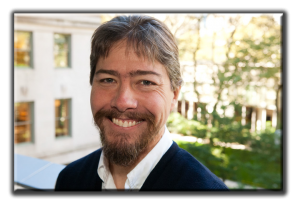 Erec Stebbins is the author of The Ragnarök Conspiracy (from Seventh Street Books) and Extraordinary Retribution (from Twice Pi Press). He is a biomedical researcher who writes political and global thrillers, science fiction, narrated storybooks, and more. Stebbins was born in the Midwest. His mother worked as a clinical psychologist, and his father was a professor of Romance languages at the University Nebraska in Lincoln. He received a degree in physics from Oberlin College in 1992, and a PhD in biochemistry from Cornell University in 1999. Since 2001, he has run a laboratory studying bacterial pathogens in New York City.
Erec Stebbins is the author of The Ragnarök Conspiracy (from Seventh Street Books) and Extraordinary Retribution (from Twice Pi Press). He is a biomedical researcher who writes political and global thrillers, science fiction, narrated storybooks, and more. Stebbins was born in the Midwest. His mother worked as a clinical psychologist, and his father was a professor of Romance languages at the University Nebraska in Lincoln. He received a degree in physics from Oberlin College in 1992, and a PhD in biochemistry from Cornell University in 1999. Since 2001, he has run a laboratory studying bacterial pathogens in New York City.
Sounds like he’s about one lab accident from either being a superhero or a supervillain, right? But look at that smile. That’s a hero smile. Let’s get to know Erec!
How does a “head of the Laboratory of Structural Microbiology” turn to thriller writing?
It was less turning to thriller writing as allowing myself to reengage with my creative writing activities that had been placed in deep-freeze upon entering graduate school and starting a family. The cryogenics were shut down after 9/11 (which I witnessed from my apartment window). 9/11, like most acts of global violence, was the product of numerous, intersecting historical currents that collided. America was swept up in them from experiencing victimhood on our own soil to fomenting irrational hatred towards billions of mostly innocent peoples of other faiths. We changed as a nation, and at the individual level. My response to my personal journey was a book that helped open the doors to writing again. It just happened to be a thriller (a genre I’ve always enjoyed).
What challenges and opportunities came from writing about such an of-the-moment topic like terrorism?
For me, the only “opportunity” was my personal emotional involvement. To write, for both good and bad, I have to care deeply about the subject of the novel, or 100,000 words just ain’t gonna find their way into the document. The Ragnarök Conspiracy was a novel born from a very emotional response to the 9/11 attacks and what they set in motion (similarly, my thriller Extraordinary Retribution). In fact, it was less opportunity, more necessity, as I had a story that embodied my own ambivalence about our national direction that needed to get out of me.
The challenges were more obvious after the fact (although for a scientist to write a global terrorist thriller required many long hours of background reading). I came to realize that most people like black-and-white narratives dealing with these issues—where the bad guy is clear and gets what’s coming to him—with little room for gray. As Jason Zengerle wrote in “The Beck Supremacy” (for New Republic) a few years back, there is an entire and profitable genre of “conservative” thrillers, the last ten years or so dealing often with terrorism and Islam. Some of the most popular authors in these genres publicly endorse ignoring the Geneva Conventions when dealing with terrorists (or, as they infrequently admit, suspected terrorists).
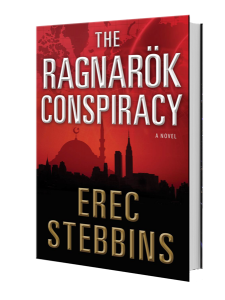 Enter The Ragnarök Conspiracy, a book not only with gray areas, but that in one enormous twist “turns the traditional terrorist thriller on its head” (author Allan Leverone). While there were some angry reviews about this calling me all sorts of common labels for the perceived anti-American, mostly there has been silence. It’s challenging to take away the shield of righteousness in this topic and replace it with a mirror. The challenge is even stronger in Extraordinary Retribution, although the pace of that novel seems to have brought in more interest.
Enter The Ragnarök Conspiracy, a book not only with gray areas, but that in one enormous twist “turns the traditional terrorist thriller on its head” (author Allan Leverone). While there were some angry reviews about this calling me all sorts of common labels for the perceived anti-American, mostly there has been silence. It’s challenging to take away the shield of righteousness in this topic and replace it with a mirror. The challenge is even stronger in Extraordinary Retribution, although the pace of that novel seems to have brought in more interest.
What do you and your protagonist John Savas have in common?
Savas is the protagonist in The Ragnarök Conspiracy, but he and the antagonist are just basically incarnate aspects of my own psyche tailored to a thriller. My own personal conflicts about the attack on New York, the global religious, cultural, and economic conflicts, and how we should respond, took shape in my writer’s mind as characters. Always needing to tell a story, a narrative grew around them embodying choices (as I saw them) that people (like myself) in the nation could make for our and the world’s future.
Beyond this metaphysical commonality, Savas is very different from me. He’s a former police officer turned counter-terrorism agent. He’s Greek. He’s a lot tougher than a writer/scientist like me. But he does share the values concerning the need to defend against possible enemies and the need to remain true to our principles as a nation, and when a Muslim CIA agent brings those into conflict he has to decide which road he’ll take. His choices ultimately determine the fate of the novel (and, since it’s a global thriller, the fate of the world, of course).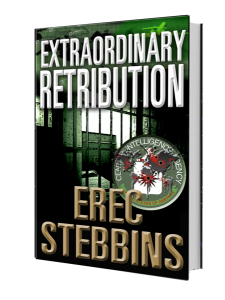
–
See? I told you I was betting on the smile.
Learn more about Erec at his website, where you can watch book trailers for both books. Get hooked: read the first chapter of The Ragnarök Conspiracy here.
The post Three Questions with…Erec Stebbins appeared first on Lori Rader-Day.
July 28, 2014
Three Questions with…Larry D. Sweazy
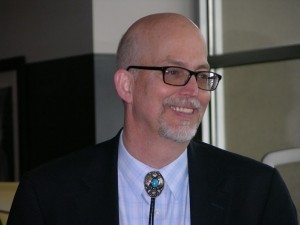 As I write this, I have not had the pleasure of meeting Larry D. Sweazy. But that seems almost impossible, given that we both have Indianapolis, Seventh Street Book contracts, and a friend in common. Of course I needed to ask him three questions. But as I’m hosting an event in Indy this weekend, I’m hoping Larry and I will be fast friends soon.
As I write this, I have not had the pleasure of meeting Larry D. Sweazy. But that seems almost impossible, given that we both have Indianapolis, Seventh Street Book contracts, and a friend in common. Of course I needed to ask him three questions. But as I’m hosting an event in Indy this weekend, I’m hoping Larry and I will be fast friends soon.
Larry D. Sweazy (www.larrydsweazy.com) is a two-time WWA Spur award winner, a two-time, back-to-back winner of the Will Rogers Medallion Award, a Best Books of Indiana award winner, and the inaugural winner of the 2013 Elmer Kelton Book Award. He was also nominated for a Short Mystery Fiction Society (SMFS) Derringer award in 2007. Larry has published over 75 non-fiction articles and short stories, and is the author of the Josiah Wolfe, Texas Ranger western series (Berkley), the Lucas Fume western series (Berkley) and a thriller set in Indiana, The Devil’s Bones (Five Star). A new mystery, See Also Murder, from Seventh Street Books, will debut in 2015. Larry also works as a freelance indexer, and lives in Indiana, with his wife, Rose.
What path did you take to becoming a published author?
I started out where every writer starts. I was, and am, a voracious reader. But I wasn’t a great student in school. Actually, I was average. I excelled at the things that interested me (lit classes, theater, the sciences; math was poisonous). One of my greatest pleasures was reading books I wasn’t supposed to, or was “too young for.” I bounced around and worked a lot of jobs, went into the military straight out of high school instead of going to college, but I always wrote in a journal. I found writing to be the most comfortable way to express my creativity. It wasn’t until I was 30 that I decided to pursue writing seriously, professionally. I started out writing short stories, mostly mystery and horror, and began submitting them (before the Internet, via the mail, when it cost something). I sold my first short story to Hardboiled, a little magazine that I think still exists, for $5.00, after collecting over a hundred rejection slips. That was 1993. It’s been a long and winding road twenty-one years since, with a lot of reading, writing, and rejection slips in between.
What do mysteries and westerns have in common?
A lot actually. Most westerns involve a crime of some sort. A train or bank robbery, a crime of passion, an illegal land grab. And since there’s usually a crime, there tends to be a law enforcement or investigative element of some kind in the story. A sheriff, a U.S. Marshal, or in my previous western series, a Texas Ranger. Most all of my westerns have a mystery or thriller plot. A review (Nuvo, 07/09/14) of my upcoming western, Vengeance at Sundown (Berkley) said it is “An amalgamation of genres—Western, detective, mystery, historical realism.” I have always said that mystery readers are missing out on a lot of great writers and great stories because they overlook the western as a source of the kind of novels they seem to crave. The list of writers that wrote both westerns and mysteries is long. Start with Elmore Leonard, Donald Hamilton, A. B. Guthrie, and the list just goes on and on. Even today, writers like Loren D. Estleman continue to write in both of genres. Westerns, like mysteries, are about delivering justice, good conquering evil, taking chaos out of the world, and making it a better place. Strip the cover off of most westerns, and you will find a mystery. Strip the cover off of a mystery and you’ll find a great story. In the end, that’s what it’s about, the story.
What are the pros—or cons—to writing from the Midwest?
The Midwest has a long and impressive literary history and has produced some great writers. Kurt Vonnegut, Booth Tarkington, F. Scott Fitzgerald, Willa Cather all come to mind immediately. So there must be something here. Maybe it’s the flat land, the wide open spaces, or maybe it’s something else like the elements, the weather, what it takes to endure, thrive, and be successful here. Maybe the human struggle is a little more visible here? I don’t know, but there is room here to explore all kinds of stories, and there is the silence to do it in, especially in the winter. To me that’s a pro. The silence of winter. Con? I think it’s the attitude that it’s boring in the Midwest, it’s a collection of fly-over states, that there is no beauty here, no mountains, no ocean. But I wholeheartedly disagree. The beauty here is breathtaking. Some days you just have to look a little closer to find it…and that’s a good exercise for any writer.
Learn more about Larry and his books at http://larrydsweazy.com and http://larrydsweazy.blogspot.com/.
Follow on Twitter: @larrydsweazy
http://www.facebook.com/larrysweazyauthor
The post Three Questions with…Larry D. Sweazy appeared first on Lori Rader-Day.
July 27, 2014
Chicago launch party for THE BLACK HOUR
Celebrated the launch of THE BLACK HOUR at Chicago’s Book Cellar, a fantastic Lincoln Square independent bookstore, July 19. Thanks to everyone who attended! Thanks to Suzi and the Book Cellar staff for the great event and to Rafi Letzter for the great photos.
The post Chicago launch party for THE BLACK HOUR appeared first on Lori Rader-Day.
July 24, 2014
A few reviews and interviews
Feeling very lucky these days. Here are just a few of the great write-ups The Black Hour has enjoyed already:
An interview with Thriller Books Journal.
A very enthusiastic review from Justin, who I met at BEA in New York. He almost missed his bus reading the book!
A lovely review from the good people at Mystery People. They’re such great supporters of Seventh Street Books.
Terry Ambrose posted this review on Examiner, too, but his site has far less pop-ups.
New City let me run my mouth about my book and everything else. A helpful transcript.
And the sweetest write-up ever by John Carlson at the Muncie Star-Press. I used to live in Muncie and still have very fond memories. I met most of my best friends there, had the first date with my husband there, really got to be an adult for the first time right there in Muncie.
I’m on a Canadian librarian’s “top shelf” for summer. Hellooooo, neighbors to the north!
Keith West passes time with Amelia and likes it.
Thank you to everyone who’s taken the time to write a review, formal, informal, Amazon, Goodreads, anything. They really do help!
The post A few reviews and interviews appeared first on Lori Rader-Day.
July 23, 2014
Indiana road trip
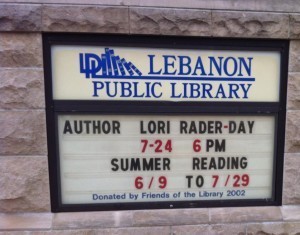
You can too go home again.
This week is Indiana launch week, with an event in my hometown at the library where I went as a kid. (They put my name on the marquee—who does not love this?)
Then I have an event in Indianapolis at IndyReads, a marvelous store on Mass Ave. (They submitted my event to NUVO. I mean, I only read NUVO for YEARS. Back when I was trying to be cool. I’ve given up on that effort.)
And then I’ll be up in Muncie for a brief howdy to the good people of the Midwest Writers Workshop. If you’re a writer of any genre looking to level up, the MWW is where you want to be this weekend. If you missed it, hey, they’ll be there next year and so should you.
But the big news this week might be a post I did for Writer’s Digest. Yes, THAT Writer’s Digest. The magazine I’ve been reading pretty much consistently since I was a teenager. Click over to read about getting an agent who loves your book AND for a chance to win a copy of The Black Hour!
That’s all the good news I can handle today. Hope to see some of you soon!
The post Indiana road trip appeared first on Lori Rader-Day.
July 22, 2014
STARRED REVIEW from Library Journal/Mystery Debut of the Month!
The Black Hour is the Library Journal’s Mystery Debut of the Month! They also gave me a STARRED REVIEW, kapow!
I don’t know why, but that’s the sound I hear. KAPOW!
News and photos from my launch party coming soon!
KAPOW!
The post STARRED REVIEW from Library Journal/Mystery Debut of the Month! appeared first on Lori Rader-Day.
July 21, 2014
Three Questions with… Leslie Lindsay
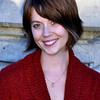 Leslie Lindsay is the author of award-winning Speaking of Apraxia (Woodbine House, 2012). Leslie blogs regularly at www.leslielindsay.com where she interviews bestselling and debut authors, shares excerpts of her work, and tips and meanderings on the writing life. She lives in Chicagoland with her husband, two daughters, and one chubby—but adorable—basset hound. She’s also working on a novel, Zombie Road, based on an urban legend set in St. Louis, Missouri. What happens when housing developments are slapped up on this so-called haunted ground? Most of all—what if those ghosts aren’t just metaphysical, but a result of your own demons?
Leslie Lindsay is the author of award-winning Speaking of Apraxia (Woodbine House, 2012). Leslie blogs regularly at www.leslielindsay.com where she interviews bestselling and debut authors, shares excerpts of her work, and tips and meanderings on the writing life. She lives in Chicagoland with her husband, two daughters, and one chubby—but adorable—basset hound. She’s also working on a novel, Zombie Road, based on an urban legend set in St. Louis, Missouri. What happens when housing developments are slapped up on this so-called haunted ground? Most of all—what if those ghosts aren’t just metaphysical, but a result of your own demons?
How did you become a writer?
It’s more like how did I *not* become a writer. From since I can remember, I have had a love for the written word. Curled up in my closet reading Babysitters Club books, or Nancy Drew, the clothing from above dangling onto the top of my head—this is where life was safe and secure as I escaped behind the cover of books.
Then, sometime in elementary school, tried my hand a few very bad attempts of books. Something about Ellican the alien who came to Earth and did what…I can’t even remember?! Of course, I had a diary where I penned everything from my nightly dreams to which boy I was crushing on. As I got older I was invited to attend special Young Author events hosted within my school district.
But then, I got these ideas that writing was a hobby, and I’d better pick a “real career.” I gravitated toward architecture for awhile, drawing floorplans like there was no tomorrow. But there was. And so I shifted my sights from architecture to medicine. All the while, I read voraciously—Lois Duncan and Joan Lowry Nixon—books I purchased with hard-earned babysitting money at B. Dalton. I always said, “someday I’m going to write a book,” not really knowing if it would be fiction, or nonfiction, or perhaps both!
I went to college. I majored in nursing. Neverminding that I found the vernacular and word-study of Latin body parts more fun than the actual healing of them. I got a degree, sat for the boards. Practiced child psychiatry at The Mayo Clinic for more than five years. All the while, I thought about writing. I even had my patients keep detailed journals. I wrote smallish, educational brochures for in-house hospital use. I started a memoir about a child’s perspective of a parent’s mental illness, pounding out pages before my evening shifts started. And then, it became too emotional to carry on.
Fast-forward a few years. A baby is born. Mine. She’s beautiful. She doesn’t talk. She barely babbles or coos. I worry. Another one comes along. And I write a book for her in the form of letters while I’m expecting. The first baby is diagnosed with childhood apraxia. I know nothing about this disorder. While raising two young kids, I research like mad, culling all of the information a can get my hands on, all while taking notes. I’m told, “You should write a book.”
“Nah…I couldn’t possibly. It’s *me* who needs a book!”
And then I do. Speaking of Apraxia is published in 2012. The baby is now 9. Her sister, 7. They won’t stop talking. Now.
And then, the fiction bug came back. Writing, it seems won’t leave me alone.
What gymnastics do you go through to get your writing done?
The creative life is often riddled with questions, lack of confidence, and everything in between. So sometimes there are “mental gymnastics,” my brain must hop through all day. But when the time comes to actually sit down, roll up the sleeves, and get to work…well, it’s a matter of just diving in. I often begin by reading yesterday’s work. What seemed brilliant at the time may need some real work. I do that. Then, I get inspired to start something new. A chapter, a blog, whatever. And usually that gets me “warmed up” enough to really get into the flow.
What one thing have you done to progress your writing the most?
Working with a critique partner, hands down. I’ve gone to plenty of writing groups over the years and while a community like that is helpful, it’s often too global for me. One person likes what you share, another doesn’t. Still yet, another will offer suggestions for a completely different premise, and you’re like, “Huh?” Don’t get me wrong: there’s a time and place for group feedback, but for me, subbing a group with a single partner who knows my quirks, habits, problem areas, and most of all—the full story I am trying to tell has made all the difference.
Photo by Rachel Larson

The post Three Questions with… Leslie Lindsay appeared first on Lori Rader-Day.
July 16, 2014
Interview with Susan Spann, writing samurai
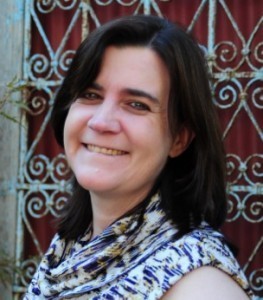 I met Susan Spann through The Debutante Ball. Technically speaking, Susan had a lot to do with me being a Deb on that site. She was a Deb in 2013 for her debut, Claws of the Cat (Minotaur). And today we celebrate the release of her second book in the Shinobi series, Blade of the Samurai, which came out yesterday. *CONFETTI DROP.*
I met Susan Spann through The Debutante Ball. Technically speaking, Susan had a lot to do with me being a Deb on that site. She was a Deb in 2013 for her debut, Claws of the Cat (Minotaur). And today we celebrate the release of her second book in the Shinobi series, Blade of the Samurai, which came out yesterday. *CONFETTI DROP.*
Susan is also a lawyer who runs the phenomenal Twitter chat #publaw. When not writing or representing clients, Susan enjoys traditional archery, martial arts, horseback riding, online gaming, and raising seahorses and rare corals in her highly distracting marine aquarium. Susan lives in Sacramento with her husband, son, two cats, one cockatiel, and a multitude of assorted aquatic creatures.
Welcome, Susan!
When did you start writing mystery? Why are you drawn to it?
I started writing mystery in spring of 2011. Before that, I’d written four (unpublished) historical fiction manuscripts, each better than the one before but all lacking “something” (translation: the agents I queried didn’t sign me).
In March of 2011, I was standing in front of the bathroom mirror, getting ready for work, when a voice in my head said “All ninjas commit murders, but Hiro Hattori solves them.” I’d never written a mystery (though I’ve loved mysteries and thrillers all my life) but I knew immediately that I had to write that book.
Which, of course, became a series.
Your books are historical mysteries about a ninja. Let’s ask the real question on everyone’s mind: How did you get to be so cool?
LOL! I’m a geek from way back. Apparently, once you’re over 40, “geek” becomes cool.
OK, how about…why a ninja in 16th century Japan? How did you get interested in the topic?
After being attacked by ninjas in the bathroom (see above…) I had no choice but to write Hiro’s story. Fortunately, I’ve also loved Japan and Japanese history for years. I fell in love with medieval Japan after seeing the SHOGUN miniseries back in 1980 (the one with Richard Chamberlain in the starring, and only Western, role). The day after the miniseries ended, I went to the library and checked out James Clavell’s book (also titled SHOGUN) which inspired the miniseries—and also inspired my deep love of Asian cultures.
Years later, in college, I majored in Asian Studies, with a concentration in Chinese and Japanese history and culture.
Do you practice any martial arts?
I’m not currently practicing, but I have studied Tae Kwon Do and Hapkido, a pair of Korean martial arts, and also a little Wushu (Chinese martial arts). As soon as I find a good local dojo, I intend to start practicing Kendo, and possibly also Aikido—both forms of Japanese martial arts.
Have you been to Japan?
It surprises many readers to learn that, despite the level of detail in my novels, I have never actually been to Japan. Instead, I’ve relied on my studies and worked with Japanese experts (residents of Kyoto) who help me with fact checking and send me photographs of the locations I use in the novels—many of which still exist. However, I’ll be spending several weeks in Japan next year, doing research for the next novels in the Shinobi series.
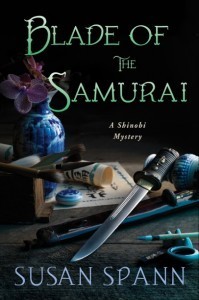 Is there anything you learned from your first publishing experience that you’re putting to use this time?
Is there anything you learned from your first publishing experience that you’re putting to use this time?
How to manage fear and expectations. Publishing a novel is a dream come true (regardless of the form, format, or path the writer takes) but it’s also a terrifying experience in many ways. As long as you stay unpublished, your work is TOTALLY AWESOME and nobody can ever tell you differently. The minute you publish…other people get to have opinions about your work.
As a first-time author, I wondered whether people would read my work, whether anyone would like it, and whether I’d have a stress-related heart attack before release day came. With this release, I’ve been much more relaxed—due, in no small part, to a core group of writing friends and the readers who enjoyed the first book and tell me they’re eagerly waiting for the second.
That’s not to say I don’t have fears. I’ve accepted that fear (or anxiety, if you prefer) is a writer’s constant traveling companion. The difference is, I’ve learned that releases are something to celebrate, and that it’s the readers and friends who love you that deserve the writer’s appreciation and focus.
How do you inspire yourself to get past difficult moments in writing and editing?
I call it “writing through the mud”—and though I wish that included some glamorous, magical answer to the problem, the reality is I simply sit down and bang out words until they start feeling good again.
When inspiration is really low, I sometimes turn and watch the fish and corals in my aquarium for a while. The tank sits just to the right of my writing desk (within arm’s reach) and it offers a great escape when the thoughts won’t flow. Usually, a few minutes of fish, crabs, and corals is enough to get my thoughts in order and my fingers back on the keys.
What’s next for you as an author? Can you give us a hint about your work in progress?
I’m killing more imaginary friends. Hey—it worked out well the first time.
More seriously—the third Shinobi Mystery, Flask of the Drunken Master, is already with my editor at Minotaur Books and scheduled for publication in July 2015. I’m currently writing the fourth book, under the working title Blood of the Outcast.
Do you have any upcoming signings or readings?
Quite a few!
I’ll be guest hosting #LitChat on Twitter July 23 at noon Pacific Time.
As far as in-person appearances:
El Dorado Hills, CA: Thursday, July 25, 2014: 6:30pm Reading & Signing: Face in a Book Bookstore
Petaluma, CA: Saturday, July 26, 2014, 1:00PM Reading & Signing: Copperfield’s Books
Pleasanton, CA: Tuesday, July 29, 2014: 11:00 AM Reading & Signing: Towne Center Books
San Diego, CA: Saturday, August 2, 2014: 2:00 PM Reading & Signing: Mysterious Galaxy Bookstore
Citrus Heights, CA: Saturday, August 16, 2014: 1:00 PM Reading & Signing: Barnes & Noble, Birdcage
There are several more—you can find them all, along with my online book tour stops, at my website.
OK, and honestly how to do you have time to do martial arts, #publaw, the seahorses, and the raising of kids? How? Really, how?
I don’t sleep much. And I drink a whole lot of coffee.
The truth is, I take it one day at a time, and I try not to worry too much if I can’t get everything done at once. Sometimes, I do better than others at keeping all the balls in the air. Sometimes, I drop them—but then it’s just a matter of picking them up and trying again. One day, and one activity, at a time!
The post Interview with Susan Spann, writing samurai appeared first on Lori Rader-Day.




